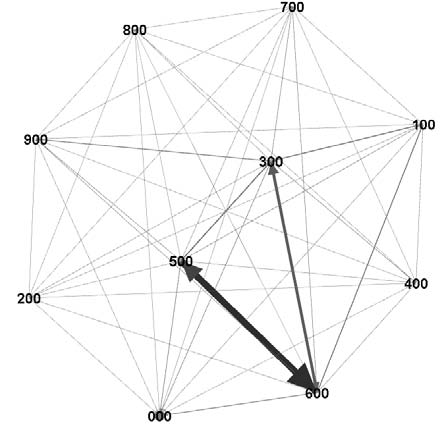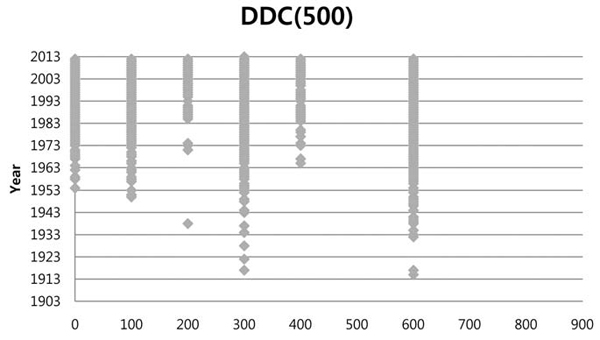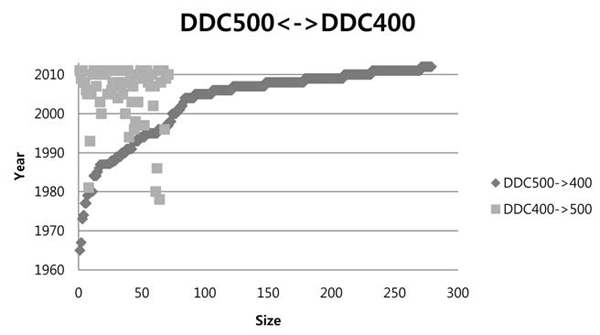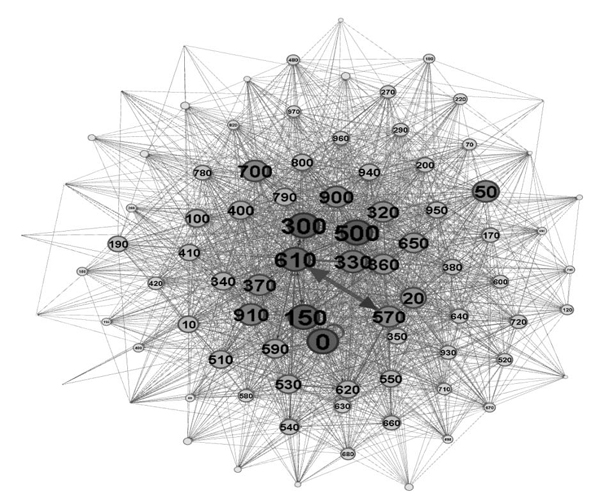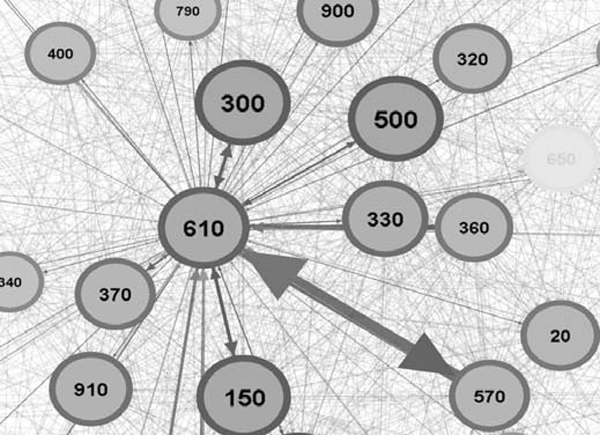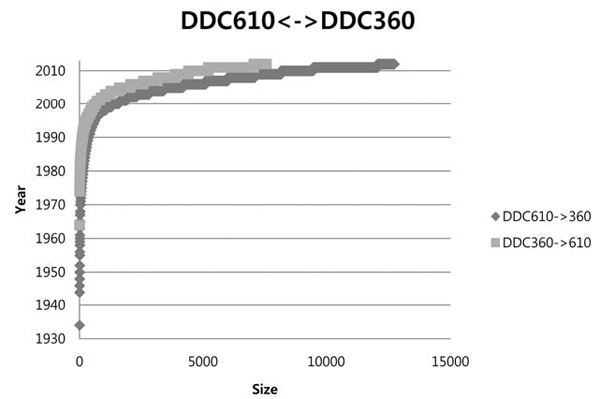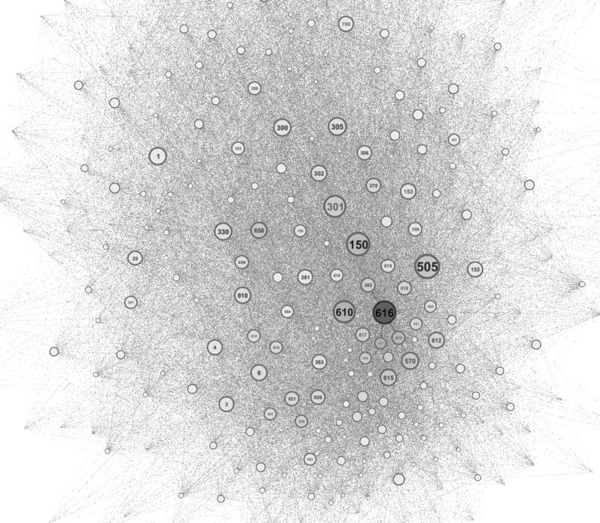
Inter‐Journal Knowledge Map using Citation Information and Subject Classification
In this paper, citation data that is cross‐referenced among journals is established using reference data in CrossRef. Using the established citation data, cited information is created and using DDC classification information, journals are classified. Using this inter‐journal citation information, subject classification and time information, the relationship among the journals is analyzed. In other words, the relationship among frequently cited journals is expressed with DDC classification, and whether the subject classification is inter‐related to journals and whether the subject journals are relevant are analyzed by year. As a result, it is shown that most journals are co‐related and that technology (600) in particular is strongly co‐related to natural science and mathematics (500) and social sciences (300). However, the analysis of journals by year shows that researches in the field of language (400) are conducted by heavily citing natural science and mathematics (500) but not the other way around with only a few citations after the year 2000. It is shown that there could be fusion among disciplines of no direct relations to each other.
Keywords:
Citation Map, Journal Classification, Citation Information, Citation Journal1. Introduction
The concept of “consilence”, first introduced by Edward O. Wilson in 2005, has rapidly emerged as a new keyword of the 21st century advocating “the great integration of knowledge” (Wilson, 1998). In addition, as the boundaries between disciplines has blurred due to the development of science and technology and the acceleration of knowledge and information, it has become more and more difficult to solve complicated research problems within individual disciplines. Academic researchers have co‐cited the information from various disciplines in order to use or apply knowledge or methodologies of other disciplines. These days, it has become a tendency that the researches cooperate closely with each other, to the extent that half the articles published by researchers in Germany are produced through joint research. Citation among journals, which is the medium for diffusing and transferring scientific knowledge, represents “Knowledge Flow”, and the direction of citation as to what is citing who or is cited by whom expresses the relationship of influence and dependence among journals (Park, 2011).
References in an article tell the fact that the researcher refers to or directly cites certain information from the previously conducted researches when he or she publishes his or her research results, and therefore refers to the literature information that affects the formation of the article. Citation analysis using references is a very useful method for analyzing the bibliographical relationship between the citing document and the cited document, and its characteristics, through the citation network. It has served as an importance source of information for identifying the flow of knowledge and the development trend of academic disciplines and recently is being used as a means for identifying the intellectual structure of academic disciplines and the scholarly communication. Furthermore, the structural analysis of the citation network provides an opportunity to identify the citation relationship among certain disciplinary areas and what subject is more intensively cited to play a central role in citation among academic journals.
All academic disciplines form and develop their own theories based on the information obtained from individual research activities. In order for a new research to be conducted, however, not only the theories and research results from the corresponding discipline but also other interdisciplinary theories and research results should be cited. In conclusion, the citing document and the cited documents are in a complementary relationship in which they affect each other and through which the academic research develops more diversely and the scope of academic network gets bigger. R. N. Broadus once stated that other disciplinary fields cited by sociological researchers in the United States are focused on the social sciences, with an exceptional inclusion of medical field (61.0%) (Kim, 2009). Such free interdisciplinary exchange and integration beyond the boundaries of individual disciplines can be interpreted as a result of the trend that disciplines become more segmented and that the demand for combining knowledge of different disciplines is increasing.
The studies performed to examine the knowledge structure of a discipline using the citation information have been focused on the attempts to identify core journals by examining the frequency of citation of each academic journal in the discipline or analyzing the intellectual structure of the discipline. In addition to such simple analysis of citation frequency, various network centrality indices were measured through the analysis of citation networks among academic journals (Jo, 2012). Earlier studies were mainly performed in various subject areas but limited to certain disciplinary fields, so a need for examining and analyzing what effects the citation data has on different journals in a macroscopic point of view has emerged.
Therefore, this paper aims at the following: classifying journals included in different areas of knowledge by DDC subject categories and analyzing the correlations among the journals, using the citation data contained in the references; and identifying what kind of relationship the journals had in the past, what kind of relationship they have now, and what are the reasons for that, through the analysis of journals by year.
2. Related Works
As the need for information knowledge increases, efforts to create Knowledge Map using various databases in various areas have been made at home and abroad (Won, 2009). Knowledge Map performed on the basis of citations is a means of expressing the cooperative structure and status of disciplines related to a certain field by visualizing them in a network format. It can be considered as Citation Tree that reflects the citation information of previous researches and subsequent researches. It is very useful for identifying the interdependent relationship of diverse disciplines and analyzing the structural properties of the academic network and the roles and positions of the academic journals within that network. With Knowledge Map, it is possible to promptly identify and analyze the structural research information and the hidden citation trend, and understand what the subject area is and what areas are being newly developed, by rearranging the citation information according to “subject areas.”
Analytical studies about references began in the 1970s and in Korea, various studies have been conducted for the analysis of references in respect to the fields of electrics, electronics, mechanical engineering, medicine, and computer science and overseas, the studies have been carried out with regard to agriculture, mathematics, physics, chemistry, engineering, electrical, mechanical, veterinary medicine, economics, sociology, and education (Ko, 2005). Recently, the use of large‐scale citation index database has become general, and the scope of search and citation analysis services provided has also been gradually expanded. Web of Science (WoS) offered by Thomson Reuters and Scopus provided by Elsevier are representative citation database systems, which provide services to systematically manage the citation information in various disciplinary fields including science, technology, medicine, and social science and to search accurate citation information. The researchers can identify current research partners all around the world and search for future partners, using Scopus. Therefore, Scopus can be considered as an innovative research evaluation tool (KISTI, 2011‐1). In 2011, Google and Microsoft released free tools that can track research areas of the hottest issue by statistically analyzing the citations by researchers and visualizing the academic network (KISTI, 2011‐2). In addition, the citation analysis services in the form of complete reports like Journal Citation Reports (JCR) are used for identifying the academic research trends and evaluating their performance, and new analysis report services like Essential Science Indicators (ESI) and SciVal Spotlight have gradually emerged (Lee et al., 2010).
Data Bases and Logic Programming (DBLP) computer science reference list at the University of Trier in Germany is one of the index systems widely used by many computer‐related researchers (DBLP, 2013). It provides the author and article search service and maintains the lists of academic journals, academic conferences and books, and its author search includes co‐author search service too. It also services the information about authors with whom the searched author has done collaborative researches.
The central library of Research Centre Julich in Germany is a specialized library of the research institutions, which provides a variety of quantitative information analysis results such as analyses of comparison and citation with other research institutes around the world, network analyses, research maps, hot topics in the scientific research community, ranks in the science fields, and calculation of the relative citation rate. In addition, it identifies the self‐citation rate and defines the interdisciplinary characteristics of the frequently cited journals, and conducts the bibliometric academic activities related to the bibliometric services by issuing reports like ‘Bibliometric Analysis in Science and Research’ and other analysis guidelines (CRLCJ, 2013).
Copenhagen University Library Information Service (CULIS) provides ‘Bibliometric Service’ as part of research information service. It is actively supporting the university’s research projects by identifying h‐index and other citation indexes for quantitative information analysis, consulting on bibliometric research indicators for research operations, and creating the Mapping of Research to identify the central researchers in certain research fields (Park, 2013).
As the Swedish government started to relate the funding for researches with the bibliometric indicators in 2008, Lund University Library launched the activities to respond to it. The Library provides the University with relevant knowledge and latest information through the quantitative information analysis of research achievements, and the University’s managers and researchers with the results of analyzing the evaluation of outside researches. And interpretation of the role is to provide. It also creates the Mapping of Research for each research field, so that the researches can understand that international cooperation, research clusters and research trends and keep track of the latest trends in research (Lee, 2013).
National Institute of Science and Technology Policy (NISTEP) of Japan released “Science Map 2008” in May 2010, which analyzes the trends in scientific researches. This policy aims at measuring the dynamic changes of scientific researches on a regular basis. For this, a database of articles with high citation rates among the articles published (in 22 fields including clinical medicine, zoology, botany, chemistry and physics) for the past six years from 2003 to 2008 was analyzed to, and the qualitative change in interdisciplinary and convergent areas and the dynamics of scientific researches were visualized through mapping of the research areas (KISTI, 2008).
In Korea, the only citation index service and journal citation indicator service in the field of science and technology is Korea Science Citation Index (KSCI) offered by Korea Institute of Science and Technology Information (KISTI) (Jung et al., 2011). It provides relevant indexes like impact indicators, number of citations, and number of being cited, with regards to 400 thousand articles published in 760 major national science and technology journals since 2002 and 7,100 thousand pieces of literature referenced in those articles (KSCI, 2013). KISTI has promoted CrossRef/DOI. This project supports the overseas distribution network through which the academic information producers like academic institutes and organizations can be published in the international journals. For this, KISTI manages participating academic institutes, participating journals, DOI numbers, CrossRef carry‐out, deposit results and errors, through the DOI registration support system. In addition, Cited‐by linking service provided by CrossRef based on DOI has been serviced by the community of Institute of Science and Technology since 2009 (Jung, Kim, & Park, 2010).
National Research Foundation of Korea manages Korea Citation Index (KCI), which provides the analysis of citations among journals similar to SCI of Institute for Scientific Information (ISI). The KCI has been proposed in order to complement the fact that domestic journals lack a system to provide information about articles and to conduct qualitative assessment of the articles. To this end, KCI provides bibliographies, statistics and citation information, builds the citation index database using the information collected through article evaluation and support projects, and provides the citation and article information based on the built database (KCI, 2013).
The citation analyses previously conducted in Korea and overseas were aimed at being used by institutions as basic data for developing book collections or providing information services through the analysis of researchers’ citation behaviors. They were mostly focused on identifying or analyzing the positions of articles of particular subject areas in journals, literature utilization rate of a certain subject field, development and growth of the subject area, authors’ citation patterns and citation structures, the language of literature, years published, countries published, subject type analysis, literature growth rate, authors’ productivity, and co‐author status. Recently, however, researches are underway with an aim to identify the latest trends of researches through the analysis of knowledge transfer or knowledge structure, so that certain agencies or national institutions can provide basic data for the journal management and the development of information services, taking the regional characteristics into consideration.
Santo and Walker (1978) stated that the citation analysis can be applied to identifying and measuring the relevance between two disciplines or among many different disciplines. Van Raan (2003) created an inter‐journal bibliometric map for the micro‐electronics field, which consists of 18 sub‐categories, in order to track how scientific knowledge has developed, centering on the interdisciplinary relationship, in the situation that a number of millions of scientific journals are published every year. He asserts in this study that the bibliometric mapping technique has potential for development and emphasizes that it is the only way to identify the knowledge structure patterns in the research field.
An, Janssen and Milios (2004) attempted in his research to express the computer science literature information in directional graphs. These literature graphs can be used for searching the research areas and for measuring the relationship between research areas, and can track how a certain research has developed over time . Chowdhury and Chowdhury (2004) proposed a visual knowledge map using DDC as a means for complementing online information search, while emphasizing the fact that it has become easy to select search words in the online search environment through the knowledge map that shows diverse concepts and the relationship among those concepts. Boyack, Klavans, and Börner (2005) presented a knowledge map by analyzing about 7,000 natural/social science articles published since 2000 in ‘Scientometrics’, a quantitative information analysis journal, and examined what differences are there in the subject areas by comparing the co‐citation and the inter‐citation analysis methods. Calero Medina (2011) presented how to identify what journal is the most deeply related to a certain journal, based on the network theory. He also insisted that the network map shows how a mutually influential relationship among journals is established depending on the citation relationship, beyond the boundaries of traditional disciplinary fields. Lee (2008) named a tool for visually analyzing the structural relationship among all disciplines “Global Map of Science,” and presented Korean Global Map of Science by using the pathfinder network widely used as a tool for representing the interdisciplinary connection information in network and also using the clustering‐based network algorithm. Lee and Kwak (2011) measured the correlation of diverse research fields in Korea by analyzing the simultaneous keyword use in 7,616 academic articles in 80 academic journals listed in the Korea Research Foundation in 2009. As a result, it was concluded that the density of keywords from engineering and natural sciences appeared the highest and that of humanity the lowest.
While the majority of the above‐mentioned studies focused on the citation analyses which deal with specific subject areas, this study includes the yearly analysis of journals in the citation analysis in order to analyze what kind of relationship the journals had in the past, what kind of relationship they have recently, and why.
3. Building the Citation Map
The reference metadata obtained from CrossRef metadata is as shown in Table 1. It consists of journals, journal_issues, journal_articles, titles, and reference lists. In this paper, a reference system is configured centering on journals, journal issues, articles, references and co‐authors, and related reference schema is designed. In particular, as there are a number of articles, references and co‐authors, the system is designed with distribution taken into consideration.
As shown in Table 2, the journal schema must use journal name, abbreviated journal name, ISSN, and Digital Object Identifier (DOI). The abbreviated journal name in particular is used most, the reference data is essential for future journal matching. The article schema information in Table 3 is composed of article title, month and year published, first page of the article, and DOI. In addition, it is made easy to find a journal and its volume information, using key values for the journal and for its volume information.
Reference data schema, as shown in Table 4, consists of reference number, journal title, ISSN, author name, and first page of the article. The reference data provided by CrossRef has a blank field when there is DOI value. Therefore, in order to provide the reference service only with DOI value, it is necessary to find the corresponding article and enter data values for journal title, article title, year published and others. The article key value is also required to link the article to the reference list.
In this paper, a system is built using 129 Gbyte data for the study of citation map.
As shown in Table 5, there are 266,142,374 article citation tables and 28,936,138 journal article tables in the reference data. The articles cited information between the article data and the reference data is contained in ARTICLE_CITED_TABLE and, when they are matched based on DOI, there are about 13 million cases. The number of journals that contain these articles are 11,283. In other words, about 11 thousand journals have DDC classifications, amounting to 50% of the total number of journal metadata.
In this paper, the analysis of relationship between different disciples or between journals was the major concern. So, 320,672 MAP_OF_CITED_DDCs were analyzed, by removing the same subject classification relationships from 13 million articles cited in MAP_OF_CITED_JOURNALS. In order to represent the citation relationship among journals, Gephi version 0.8 tool was used.
Figure 1 shows the classification of about 11 thousand journals that have DDC classification values. Among a variety of journals that are widely distributed all over subject areas, journals in the fields of social sciences (300), natural science and mathematics (500), and technology (600) appear prominent. Especially, the journals related to the field of technology (600) are the most prominent.
4. Analyzing the Citation Map
In this paper, it was analyzed what kind of relationship a subject classification for certain journals has with other journals. Except the co‐citation information for journals, which was included in the same subject classification, it was confirmed that 320,672 subject classification data from journals with different subject classification are correlated.
With these 320 thousand correlated classification data, the correlation data was analyzed in terms of category, sub‐category and sub‐sub‐category.
4.1. Category Perspective
In order to analyze the inter‐journal citation information from the category perspective, the inter‐journal classification information was rearranged and reconnected in terms of categories.
The inter‐journal citation information was analyzed from the DDC category perspective, which is shown in Figure 1. It appears that researches in general are conducted through co‐citation among all subject fields. According to DDC classification, researches in the field of technology (600) are actively underway in a close relation to natural science and mathematics (500) and next to social sciences (300).
The result of analysis from the category perspective shows that researches in all disciplines are conducted in correlation to each other and the journals in the fields of natural science and mathematics (500) and technology (600) in particular actively cite articles from each other. While the interdisciplinary relationship was analyzed using the inter‐journal co‐citation information and the subject classification information, it was impossible to clearly identify since when the natural science and mathematics (500) and the technology (600) had established an active co‐citation relation and what relation the natural science and mathematics (500) and the language (400) had. Therefore, in this paper, it was attempted to analyze a more accurate relationship including the co‐citation information, subject classification and time concept among journals.
Figure 2 shows the relationship by year among subject classifications in the journals of natural science and mathematics (500), which are cited by other journals. The fields of natural science and mathematics (500), technology (600), social sciences (300) have conducted active researches continuously through co‐citation since long time ago, while the fields of language (400), arts; fine and decorative arts (700), and literature and rhetoric (800) have conducted researches through co‐citation until recently.
Figure 3 shows the cases of co‐citation between natural science and mathematics (500) and technology (600) by year. It is shown that the journals in the field of technology (600) have conducted diverse researches with actively citing the journals in the field of natural science and mathematics (500) since the early 1900s, but the rate of co‐citation tends to have become very high since the 2000s. Considering that the technology (600) cites the natural science and mathematics (500), it can be said that the researches in the field of applications are conducted based on basic sciences.
Figure 4 shows the co‐citation between the natural science and mathematics (500) and the language (400). The journals in the field of language (400) show that the researches had been conducted without not much citing the journals in the field of natural science and mathematics (500) for a while. Since 2000, however, the journals in the field of natural science and mathematics (500) started to cite those in the field of language (400), showing that the interdisciplinary researches are gradually increasing. In order to deal with the important latest issues or to further new academic development, the natural science and mathematics (500) cites the language (400) a lot. Therefore, in order to understand the relationship between these two disciplines, it is necessary to conduct additional analysis by adding the concept of time.
4.2. Sub‐category Perspective
In this paper, the inter‐jour citation information was analyzed in terms of the sub‐category in order to analyze the inter‐journal relationship in detail. The cross‐classification information was classified again by journal according to sub‐categories, and then co‐citation information was connected to the classifications.
Figure 5 and Figure 6 show the results of analyzing the inter‐journal citation information in terms of DDC sub‐category, which is a lower classification concept than DDC category. In the sub‐category, medical sciences; medicine (610) and life sciences (570) do a lot of co‐citations, which means that researches are actively underway in those fields through co‐citation. It is shown that researches in the field of medical sciences; medicine (610) have been conducted in close relation to psychology (150), natural sciences and mathematics (500), social sciences (300), education (370), and social services; association (360).
It is shown that the analysis of co‐citation from the sub‐category perspective can reveal more detailed relationship among journals than the analysis from the category perspective. In the field of medical sciences; medicine (610), journals of diverse subjects are correlated. In particular, researches in the field of medical sciences; medicine (610) are actively conducted through co‐citation with the life sciences (570). Psychology (150), geography and travel (910), and social services; association (360) also have close relations medical sciences; medicine (610).
Medical sciences; medicines (610) and social services; association (360) were not a highly correlated but as shown in Figure 7, they have become correlated with one another since the 1930s. Also, the frequency of citation of medical sciences; medicines (610) by social services; association (360) is increasing.
It was expected that the correlation between medical sciences; medicines (610) and geography and travel (910) was low. As shown in <Figure 8>, geography and travel (910) started citing medical sciences; medicines (610) only from the mid‐1980s. However, since the 2000s, the frequency of citation of geography and travel (910) by medical sciences; medicine (610) has gradually increased.
4.3. Sub‐sub Category Perspective
In order to analyze the inter‐journal relationship in far more detail, the inter‐journal citation information was analyzed from the sub‐sub‐category perspective.
Figure 9 and Figure 10 show the result of analyzing the inter‐journal citation map from DDC sub‐sub‐category perspective, a classification concept lower than DDC sub‐category. It is shown that researches in the field of diseases (616) are conducted in close relation with medical sciences; medicine (610), special welfare problems & services (362), physiology (571), life sciences (570), surgery & related medical specialties (617), and psychology (150).
The analysis in terms of the sub‐sub‐category revealed more detailed relations than the analysis from the sub‐category perspective. The analysis showed that the subject field of diseases is highly correlated to such subject fields as special welfare problems & services (362), physiology (572) and biochemistry (571), and that the higher subject fields of diseases (616), medical sciences; medicine (610), psychology (150), and sociology and anthropology (301) are not only highly correlated but also connect each other’s research results.
5. Conclusion
In this paper, the interdisciplinary correlation was analysis in terms of DDC classifications (category, sub‐category, and sub‐sub‐category) using the citation information in the large‐capacity cross‐reference data. By applying the concept of time, the interdisciplinary correlation from the past to the present was examined.
The result of analysis in terms of category showed that the journals in the fields of natural science and mathematics (500) and technology (600) were actively conducting researches through co‐citation. What is important is that, in macroscopic perspective, all disciplines conduct researches in correlation to each other. The interdisciplinary analysis by year revealed the following about the interdisciplinary relations: Natural science and mathematics (500) and technology (600) had conducted researches in correlation to one another since the past and the scope of researches through co‐citation has been gradually increasing. Until recently, the frequency of co‐citation by natural science and mathematics (500) and language (400) had been low. However, since natural science and mathematics (500) started citing language (400) in 2000, the co‐citation between these two disciplines has been gradually increasing.
The analysis from the sub‐category perspective revealed more detailed relations than the analysis from the category perspective. It is shown that the journals from diverse subject fields have correlations centering on medical sciences; medicine (610), and that medical sciences; medicine (610) and life sciences (570) are conducting active researches through co‐citation. Also, it is shown that medical sciences; medicine (610) and geography and travel (360) did not have a high correlation in the past but the frequency of citation of geography and travel (360) by medical sciences; medicine (610) is gradually increasing.
The analysis from the sub‐sub‐category perspective revealed far more detailed relations than the analysis from the sub‐category perspective. It is shown that the subject field of diseases (616) is closely related to such subject fields as social welfare problems and services (362), physiology (571), and biochemistry (572) and that active researches are underway centering on such major groups as diseases (616), medical sciences; medicine (610), psychology (150), and sociology and anthropology (301).
In conclusion, it is confirmed in this paper that all disciplines are correlated and that pure science and applied sciences are in a high co‐citation relationship. In addition, in order to analyze to a more detailed relationship, it is essential to include citation, subject classification and time concept in the analysis.
For future study, it shall be attempted to analyze the multi‐dimensional relationship among disciplines by including various elements like the relationship among authors and the relationship among keywords. Through this study in which authors and keyword, which are the center of the inter‐disciplinary relationship, will be analyzed, it will be possible to understand a future direction of interdisciplinary development.
References
-
An, Y., Janssen, J., & Milios, E.E., (2004), Characterizing and Mining the Citation Graph of the Computer Science Literature, Knowledge and Information Systems, 6(6), p664-678.
[https://doi.org/10.1007/s10115-003-0128-3]

-
Boyack, K.W., Klavans, R., & Börner, K., (2005), Mapping the backbone of science, Scientometrics, 64(3), p351-374.
[https://doi.org/10.1007/s11192-005-0255-6]

- Central Library of Research Centre Julich, (2013, May, 23), Retrieved from http://www.fz‐juelich.de/zb/EN/Expertise/Bibliometrics/bibliometrie_node.html.
- Chowdhury, S., Chowdhury, G., (2004), Using DDC to create a visual knowledge map as an aid to online information retrieval, In 8th International ISKO Conference: Knowledge organization and the Global Information Society, 9, p133-138, Retrieved from https://pure.strath.ac.uk/portal/files/144076/strathprints002624.pdf.
- Data Base and Logic Programming, (2013, May, 6), Retrieved from http://dblp.uni‐trier.de.
-
Jo, S. R., & Lee, J. Y., (2012), Journal Co‐citation Analysis for Library Services in Pharmaceutics, Journal of information management, 43(1), p159-185.
[https://doi.org/10.1633/jim.2012.43.1.159]

- Jung, E. K., Kim, B. K., & Park, J. W., (2010), Application and Effect Analysis of DOI based Service for National Academic Information, The 17th Conference of the Korea Society for Information Management, p29-32.
- Jung, E. K., Kim, B. K., Jeon, J. Y., Choi, S .H., & Kang, M. Y., (2011), Application System Plan for Scholarly Information Producer using the result of Cited‐by linking based on CrossRef DOI, The 35th Conference of the KIPS, 18(1), p1573-1575.
-
Kim, K. Y., Kim, S. Y.,, & Kim, H. M., (2012), Study of analyzing outcome of building and introducing system for preserving Full-Text of e-Journal, International Journal of Knowledge Content Development & Technology, 2(2), p5-16.
[https://doi.org/10.5865/IJKCT.2012.2.2.005]

- Kim, Y. G., (2009), Citation Dependency Analysis of Korean Sociology Using Author Citation Analysis: Especially on the Discussion of Decolonization, Journal of Korean library and information science society, 37(4), p91-110.
- Ko, S. S., Choi, S. K., (2005), Analysis on Foreign Journals Seeking Behaviors through Citation analysis, Journal of Korean library and information science society, 36(1), p441-457.
- Korea Citation Index, (2013, May, 14), Retrieved from https://www.kci.go.kr.
- Korea Institute of Science and Technology Information, (2008), Japan NISTEP 「Science Map 2008」. (iCONEXPRESS: 10), Daejon: KISTI.
- Korea Institute of Science and Technology Information, (2011), Elsevier Released the International Joint Research Network Using Scopus Data. (iCONEXPRESS: 20), Daejon: KISTI.
- Korea Institute of Science and Technology Information, (2011), Google and Microsoft, Citation Analysis Free Service. iCONEXPRESS: 18, Daejon: KISTI.
- Korea Science Citation Index, (2013, May, 6), Retrieved from http://ksci.kisti.re.kr/main/about.ksci.
-
Lee, H. Y., & Kwak, S. J., (2011), Relation Analysis Among Academic Research Areas Using Subject Terms of Domestic Journal Papers, Journal of the Korean Biblia Society for Library and Information Science, 22(3), p353-371.
[https://doi.org/10.3743/KOSIM.2008.25.4.327]

- Lee, J. Y., (2008), Analyzing the Network of Academic Disciplines with Journal Contributions of Korean Researchers, Journal of the Korean society for information management, 25(4), p327-345.
- Lee, J. Y., (2013), Bibliometrics’ Theory and Practice Ⅱ: Information Management System & Bibliometric Analysis, The 46th Korean Medical Library Association Workshop.
- Lee, J. Y., Yu, S. Y., & Lee, J. Y., (2010), Strategies for Improving Scholarly Information Service with Citation Information, Journal of information management, 41(1), p43-67.
- Medina, C., Leeuwen, T.N., (2012), Seed journal citation network maps: A method based on network theory, Journal of the American Society for Information Science and Technology, 63(6), p1226-1234.
- Park, H. S., Lee, S. J., & Na, H., (2011), Rankings, Citation Relationships, and the Network Structure of Major Korean Public Administration Journals, Korean Journal of Public Administration, 49(4), p1-24.
- Park, H. W., (2013), Review of the 46th Korean Medical Library Association Annual General Meeting & Workshop, Medical Librarian, 15(1), p12.
- Santo, A. D. E., & Walker, R. D., (1978), Measure of Interdisciplinary, Proceeding of the ASIS, 15, p278.
- Van Raan, A. F., (2003), The use of bibliometric analysis in research performance assessment and monitoring of interdisciplinary scientific developments, Theorie und Praxis, 12(1), p20-29.
- Wilson, E. O., (1998), Consilience: The unity of Knowledge, New York, NY: Knopf.
- Won, D. G., (2009), Development and Implementation of Academic Research Knowledge Map in the Social Sciences, Korea Institute of Science and Technology Information.


